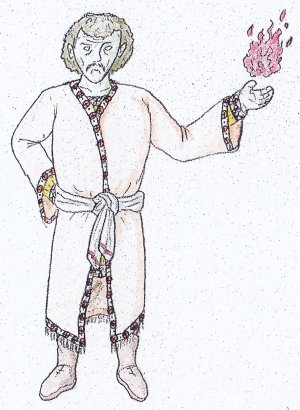Avóðans
Vóðic: Avóðeimm /aːvouːðeimː/
The avóðans1 are one of the main groups of Southlandic Elves which emigrated to the Southlands from western Jælondis during and after the horrible Fell Wars around forty years ago, along with the Maþúlans and Þiðans. Like the latter, their original homeland of Avóða is now a part of the desolate region of Amþax in southwestern Jælondis where hordes of undead beings roam the crumbling ruins and barren fields.
Avóðans are related to the vaðnans and telþalíans, both of whom are virtually extinct as distinct cultures, but historically shared a number of customs and traditions with the former, such as a distinct influence by the nomadic humans of the Maralon Steppe, a semi-nomadic lifestyle based on raising cattle and sheep (though avóðans had adopted agriculture to some extent at the time of the Fell Wars), and warrior culture based on light cavalry and infantry.
They were one of the many peoples who fought The Tetrarchy of liches in the Fell Wars, and their king Fúmas Hevóneih was one of those who lead the attack that resulted to the defeat of Jaskíó Þúlgas V, the third tetrarch to be slain, though Fúmas was consumed by the now feral undead soon afterwards.
Since migrating to the Southlands, avóðans now mostly live in towns and cities, and the former nomadic aspect of their culture has been heavily romanticized, inspiring a number of movies, shows and games, including one of the most popular tabletop RPGS in the Southlands, Hoofbeat.
While many avóðans incorporate traditional elements into their daily clothing, those living in the Southlands now wear much the same as the majority of the inhabitants in the countries they live in.
The oracles of Inhút, chosen by sortition, are held in high regard in avóðan society but their status is temporary, much like their counterparts in certain maralonean human cultures. Divination is performed by different forms of pyromancy depending on the subject, often by adding sacred substances like salt, mead or cherry leaves and observing their effects. Unlike the latter, the oracles are exiled rather than executed by fire magic, and expected to live as beggars afterwards.
Song and dances are important elements of avóðan rituals, as they are traditionally used to teach stories, myths and laws; avóðan leaders are expected to be able to recite the laws of their people from memory, for example.Fúmas Hevóneih: Last king of Avóða.
Múlþis Teih: Represented avóðans at the Ötera Conference.
The avóðans1 are one of the main groups of Southlandic Elves which emigrated to the Southlands from western Jælondis during and after the horrible Fell Wars around forty years ago, along with the Maþúlans and Þiðans. Like the latter, their original homeland of Avóða is now a part of the desolate region of Amþax in southwestern Jælondis where hordes of undead beings roam the crumbling ruins and barren fields.
Avóðans are related to the vaðnans and telþalíans, both of whom are virtually extinct as distinct cultures, but historically shared a number of customs and traditions with the former, such as a distinct influence by the nomadic humans of the Maralon Steppe, a semi-nomadic lifestyle based on raising cattle and sheep (though avóðans had adopted agriculture to some extent at the time of the Fell Wars), and warrior culture based on light cavalry and infantry.
They were one of the many peoples who fought The Tetrarchy of liches in the Fell Wars, and their king Fúmas Hevóneih was one of those who lead the attack that resulted to the defeat of Jaskíó Þúlgas V, the third tetrarch to be slain, though Fúmas was consumed by the now feral undead soon afterwards.
Since migrating to the Southlands, avóðans now mostly live in towns and cities, and the former nomadic aspect of their culture has been heavily romanticized, inspiring a number of movies, shows and games, including one of the most popular tabletop RPGS in the Southlands, Hoofbeat.
Culture
Apparel
Avóðan clothing, now mostly worn during special occasions, is similar to that of the Erens, consisting primarily of a jacket of sorts that's fastened with a sash, a short tunic underneath for men and longer dress for women, long trousers which are generally less baggy than those worn by most Jútrilían Elves, and leather boots. The jacket is similar for both men and women, and is both overall longer and plainer than is among the jútrilían elves from the coast of Niþvú Sea. Wide cloaks and fur hats are also worn during the winter.While many avóðans incorporate traditional elements into their daily clothing, those living in the Southlands now wear much the same as the majority of the inhabitants in the countries they live in.
Religion
Traditional avóðan religion combines elements of elven pyrolatry with maralonean human traditions, centered around Inhút, god of fire, often depicted with a torch in one hand and a lightning bolt in the other, symbolizing his dual celestial and chthonic nature. White horses are sacrificed to him at certain times of year, during which small cakes are eaten after being dipped into the blood, while some of the liquid is used to make simple bread to be offered to spirits of the ancestors.The oracles of Inhút, chosen by sortition, are held in high regard in avóðan society but their status is temporary, much like their counterparts in certain maralonean human cultures. Divination is performed by different forms of pyromancy depending on the subject, often by adding sacred substances like salt, mead or cherry leaves and observing their effects. Unlike the latter, the oracles are exiled rather than executed by fire magic, and expected to live as beggars afterwards.
Song and dances are important elements of avóðan rituals, as they are traditionally used to teach stories, myths and laws; avóðan leaders are expected to be able to recite the laws of their people from memory, for example.
Notable avóðans
1Original icelandic: Avóðar, singular: Avóði.
Parent ethnicities
Related Locations




Comments